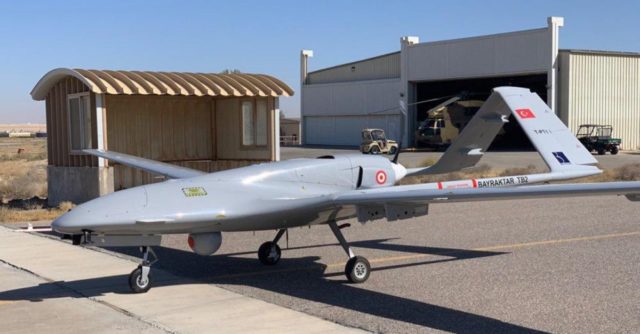
Baku’s Success in Using Turkish Drones Raises Question: Could Ukraine Use Them Against Russia in Crimea?
Publication: Eurasia Daily Monitor Volume: 17 Issue: 179
By:

The Azerbaijani military’s use of Bayraktar TB2 unmanned aerial vehicles (UAV), purchased from Turkey, played such a prominent role in Baku’s victory over Armenian forces during the Second Karabakh War (September 27–November 9, 2020) that defense analysts around the world are now focusing on how their countries may utilize similar unmanned systems and how they could respond if such drones are used against them (Regnum, accessed December 16; Ecfr.eu., November 24; see EDM, November 9). Notably, Azerbaijan employed its Bayraktars to identify and attack Armenian forces as well as to provide a real-time picture of the battlefield that was useful for both strategic planning and propaganda (see EDM, October 15). Now, Vadim Nozdrya, who heads the Ukrainian arms trade state committee Ukrspetseksport, has announced that Kyiv is prepared to purchase from Turkey 48 of these battle-tested UAVs (Milliyet), December 4). That news is undoubtedly prompting analysts in Moscow to consider how Ukraine could eventually use such drones to threaten Russian control of occupied Crimea or Donbas and what Moscow needs to do in response.
Nozdrya’s words come on the heels of a declaration by Igor Fomenko, a top executive at Ukraine’s military industry firm Ukroboronprom, that Kyiv might be able to produce “its own analogue” to the Turkish Bayraktar TB2 in a year (Regnum, November 30). Together, those pronouncements suggest Kyiv has absorbed the lessons from the recent fighting in Karabakh and decided to move forward more rapidly on its UAV strategy and defense cooperation with Turkey (see EDM, November 16). That motivation by itself—even before any tangible changes become apparent on the ground—is likely to set off alarm bells in Russia, whose forces will be the most likely targets of Turkish drones deployed by Ukraine.
Anton Chablin, a Russian specialist on the Caucasus who has tracked the employment of UAVs by Azerbaijan against Armenia, points out that these Turkish drones were “actively used by Azerbaijan” not only to track down and destroy Armenian forces in the mountainous region where the war was primarily fought but also, and importantly, as a means of providing details, on a real-time basis, to the military of where these Armenian units were and where they were heading. [This] allowed the Azerbaijani command the opportunity to deploy its forces in the most effective way possible, and [it was also] a means of recording Azerbaijani victories and Armenian defeats in ways that could be put up on the social media [accounts] of the Azerbaijani defense ministry and more broadly as well” (Aktsenty, December 7).
Turkey had used domestically developed attack and reconnaissance UAVs in support of its own military operations in northern Syria and in Libya (see Terrorism Monitor, April 17; see EDM, June 11; YouTube, December 9). But until recently, it had not sold them to other countries, Chablin writes. The success Azerbaijan had in the use of these drones may help Turkey’s defense ministry meet its goal of selling $10 billion of Turkish weaponry over the next three years, something that could boost Ankara’s position as a major player in key conflicts around the world. Moreover, as Chablin notes, Turkish President Recep Tayyip Erdoğan has another reason for promoting the sale of advanced Turkish UAVs: His son-in-law, Selçuk Bayraktar, is “one of the top managers and technical experts at the Baykar Makina firm, which developed these military drones” (Aktsenty, December 7).
The concerns European analysts have shown about the Azerbaijani precedent in the use of drones in combat are likely shared by some in Moscow, Chablin suggests. Although so far, Russian commentators have only described Azerbaijan’s actions rather than discussed the implications that drones might have for Moscow itself should Ukraine deploy them against Russian occupation forces in Crimea or Donbas (Regnum, October 20, 23). The reasons Russia is likely to be concerned directly echo the factors animating discussions among European defense analysts: the fact that most anti-aircraft defense systems do not work well against low-flying and slow-moving UAVs, and that the real-time information these drones can provide tends to mitigate whatever other advantages of the opposing side.
As one Russian analyst, Denis Fedutinov, contends, Azerbaijan’s success in using drones against Armenia is an obvious advertisement for the Turkish weapon and for unmanned aerial systems as such. Therefore, he suggests, there is likely to be intense discussions in world capitals about whether UAVs require a fundamental redrafting of both offensive and defensive military plans. At the same time, the lessons drawn from the autumn 2020 Karabakh war could possibly trigger a new arms race between countries like Turkey, which produce such advanced UAVs, and others, against whom those drones might be used, that will focus on the development of weapons systems capable of destroying or otherwise countering their effectiveness (Profile.ru, December 13).



